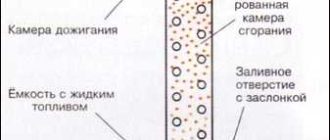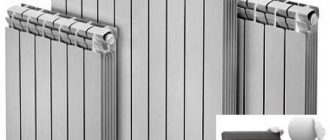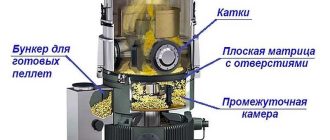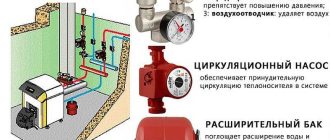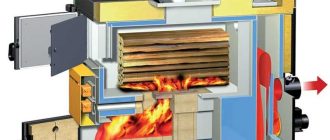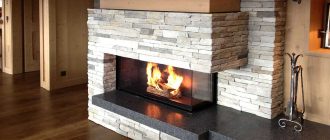Για να διατηρηθεί το σπίτι ζεστό, είναι σημαντικό να σχεδιαστεί σωστά το σύστημα θέρμανσης. Ένα από τα στοιχεία της αποτελεσματικότητάς του είναι η σύνδεση των θερμαντικών σωμάτων θέρμανσης. Ανεξάρτητα από το αν πρόκειται να εγκαταστήσετε χυτοσιδηρά, αλουμινένια, διμεταλλικά ή χαλύβδινα θερμαντικά σώματα, είναι σημαντικό να επιλέξετε τον σωστό τρόπο σύνδεσής τους.
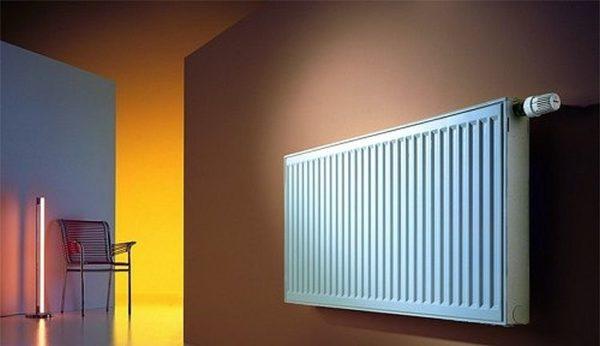
Περιεχόμενο άρθρου
Τύποι συστημάτων θέρμανσης
Η ποσότητα θερμότητας που θα εκπέμπεται από το θερμαντικό σώμα, εξαρτάται, μεταξύ άλλων, από τον τύπο του συστήματος θέρμανσης και τον επιλεγμένο τύπο σύνδεσης. Για να επιλέξετε την καλύτερη επιλογή, είναι απαραίτητο να καταλάβετε πρώτα τι ακριβώς είναι τα συστήματα θέρμανσης και πώς διαφέρουν.
Μονοσωλήνιο
Σύστημα θέρμανσης με ένα σωλήνα - η πιο οικονομική επιλογή όσον αφορά το κόστος εγκατάστασης. Ως εκ τούτου, αυτός ο τύπος διανομής προτιμάται σε πολυώροφες κατοικίες, αν και σε ιδιωτικές ένα τέτοιο σύστημα δεν είναι ασυνήθιστο. Σε αυτό το σύστημα τα θερμαντικά σώματα περιλαμβάνονται στο δίκτυο σε σειρά και το ψυκτικό υγρό περνάει πρώτα από έναν σωλήνα θέρμανσης, στη συνέχεια έρχεται στην είσοδο του δεύτερου και ούτω καθεξής. Η έξοδος του τελευταίου θερμαντικού σώματος συνδέεται με την είσοδο του λέβητα θέρμανσης ή με την ανύψωση σε πολυώροφα κτίρια.
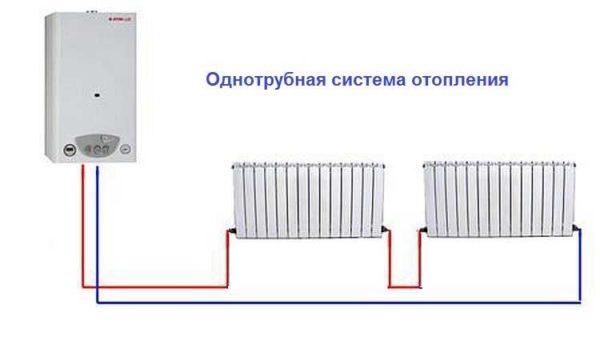
Το μειονέκτημα αυτής της μεθόδου διανομής είναι η αδυναμία ρύθμισης της θερμικής απόδοσης των θερμαντικών σωμάτων. Εγκαθιστώντας έναν ρυθμιστή σε οποιοδήποτε από τα θερμαντικά σώματα, θα ρυθμίσετε το υπόλοιπο σύστημα. Το δεύτερο σημαντικό μειονέκτημα είναι η διαφορετική θερμοκρασία του ψυκτικού υγρού στα διάφορα θερμαντικά σώματα. Εκείνα που βρίσκονται πιο κοντά στον λέβητα, ζεσταίνονται πολύ καλά, τα οποία βρίσκονται πιο μακριά - γίνονται πιο κρύα. Αυτό είναι συνέπεια της διαδοχικής σύνδεσης των θερμαντικών σωμάτων θέρμανσης.
Σύνδεση δύο σωλήνων
Το σύστημα θέρμανσης με δύο σωλήνες χαρακτηρίζεται από το γεγονός ότι διαθέτει δύο σειρές σωληνώσεων - παροχή και επιστροφή. Κάθε θερμαντικό σώμα συνδέεται και με τις δύο, δηλαδή αποδεικνύεται ότι όλα τα θερμαντικά σώματα είναι συνδεδεμένα στο σύστημα παράλληλα. Αυτό είναι καλό, διότι το ψυκτικό υγρό της ίδιας θερμοκρασίας εισέρχεται σε καθένα από αυτά. Το δεύτερο θετικό σημείο είναι ότι μπορείτε να εγκαταστήσετε έναν θερμοστάτη σε κάθε θερμαντικό σώμα και να τον χρησιμοποιήσετε για να αλλάξετε την ποσότητα θερμότητας που παράγει.
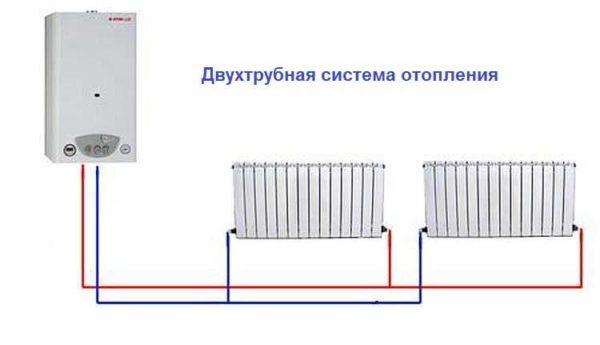
Το μειονέκτημα αυτού του συστήματος είναι ότι ο αριθμός των σωλήνων στο σύστημα είναι σχεδόν διπλάσιος. Όμως το σύστημα μπορεί εύκολα να εξισορροπηθεί.
Διαβάστε περισσότερα σχετικά με τα συστήματα θέρμανσης για μια ιδιωτική κατοικία εδώ.
Πού να τοποθετήσετε θερμαντικά σώματα
Παραδοσιακά, τα θερμαντικά σώματα τοποθετούνται κάτω από τα παράθυρα και αυτό δεν είναι τυχαίο. Η ανοδική ροή του ζεστού αέρα αποκόπτει τον κρύο αέρα που έρχεται από τα παράθυρα. Επιπλέον, ο ζεστός αέρας θερμαίνει τα παράθυρα, εμποδίζοντας τη δημιουργία συμπυκνωμάτων πάνω τους. Μόνο για το σκοπό αυτό είναι απαραίτητο το θερμαντικό σώμα να καταλαμβάνει τουλάχιστον 70% του πλάτους του ανοίγματος του παραθύρου. Μόνο με αυτόν τον τρόπο το παράθυρο δεν θα θολώσει. Ως εκ τούτου, κατά την επιλογή της ισχύος των θερμαντικών σωμάτων, επιλέξτε την έτσι ώστε το πλάτος ολόκληρου του θερμαντικού σώματος θέρμανσης να μην ήταν μικρότερο από την καθορισμένη τιμή.
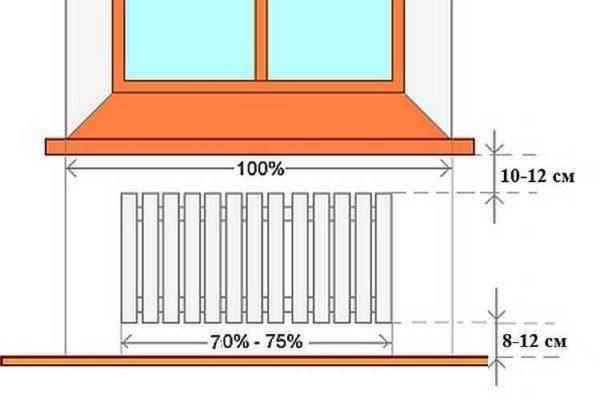
Επιπλέον, είναι απαραίτητο να επιλέξετε σωστά το ύψος του θερμαντικού σώματος και τη θέση τοποθέτησής του κάτω από το παράθυρο. Θα πρέπει να τοποθετηθεί έτσι ώστε η απόσταση από το δάπεδο να είναι στη γειτονιά των 8-12 cm. Αν είναι χαμηλότερα, θα είναι άβολο να καθαριστεί, αν το ανεβάσετε ψηλότερα - τα πόδια σας θα κρυώνουν. Η απόσταση από το περβάζι του παραθύρου ρυθμίζεται επίσης - θα πρέπει να είναι 10-12 cm. Σε αυτή την περίπτωση, ο ζεστός αέρας θα παρακάμπτει ελεύθερα το εμπόδιο - το περβάζι του παραθύρου - και θα ανεβαίνει κατά μήκος του υαλοπίνακα.
Και η τελευταία απόσταση που πρέπει να τηρείται κατά τη σύνδεση των θερμαντικών σωμάτων - η απόσταση από τον τοίχο. Θα πρέπει να είναι 3-5 cm. Σε αυτή την περίπτωση, κατά μήκος του πίσω τοίχου του θερμαντικού σώματος θα ανέβουν προς τα πάνω ρεύματα θερμού αέρα, η ταχύτητα θέρμανσης του δωματίου θα βελτιωθεί.
Πώς να τοποθετήσετε και να συνδέσετε θερμαντικά σώματα με τα χέρια σας διαβάστε εδώ.
Διαγράμματα σύνδεσης των θερμαντικών σωμάτων
Το πόσο καλά θα ζεσταθούν τα ψυγεία εξαρτάται από τον τρόπο τροφοδοσίας του ψυκτικού υγρού σε αυτά. Υπάρχουν περισσότερο και λιγότερο αποτελεσματικές επιλογές.
Θερμαντικά σώματα με σύνδεση στο κάτω μέρος
Όλα τα θερμαντικά σώματα έχουν δύο τύπους σύνδεσης - πλευρική και κάτω. Με την κάτω σύνδεση, δεν μπορούν να υπάρξουν αποκλίσεις. Υπάρχουν μόνο δύο στόμια - είσοδος και έξοδος. Κατά συνέπεια, το ψυκτικό υγρό τροφοδοτείται στο ψυγείο από τη μία πλευρά και απορρίπτεται από την άλλη.
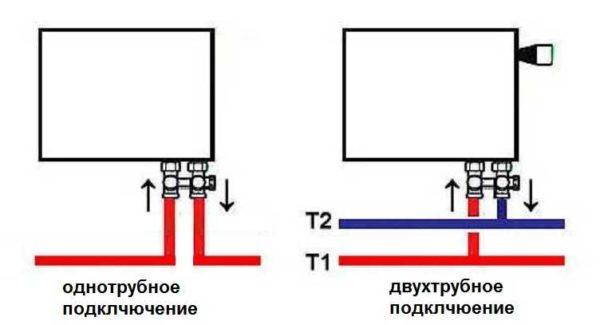
Συγκεκριμένα, το πού πρέπει να συνδεθεί η παροχή και πού η επιστροφή αναγράφεται στις οδηγίες εγκατάστασης, οι οποίες πρέπει απαραίτητα να είναι διαθέσιμες.
Θερμαντικά σώματα με πλευρική σύνδεση
Με μια πλευρική σύνδεση, υπάρχουν πολύ περισσότερες επιλογές: εδώ οι σωληνώσεις παροχής και επιστροφής μπορούν να συνδεθούν σε δύο σωλήνες, αντίστοιχα, υπάρχουν τέσσερις επιλογές.
Επιλογή αριθ. 1. Διαγώνια σύνδεση
Μια τέτοια σύνδεση των θερμαντικών σωμάτων θεωρείται η πιο αποτελεσματική, λαμβάνεται ως σημείο αναφοράς και έτσι οι κατασκευαστές δοκιμάζουν τις συσκευές θέρμανσης και τα δεδομένα στο διαβατήριο σχετικά με τη θερμοχωρητικότητα - για μια τέτοια σύνδεση. Όλοι οι άλλοι τύποι σύνδεσης είναι λιγότερο αποτελεσματικοί στην απόδοση θερμότητας.

Όλα αυτά επειδή, με μια διαγώνια σύνδεση των μπαταριών, το ζεστό ψυκτικό υγρό τροφοδοτείται στην άνω είσοδο από τη μία πλευρά, περνάει μέσα από ολόκληρο το ψυγείο και εξέρχεται από την αντίθετη, κάτω πλευρά.
Επιλογή #2. Μονομερής
Όπως προκύπτει από την ονομασία, οι αγωγοί συνδέονται από τη μία πλευρά - παροχή από την κορυφή, επιστροφή - από τον πυθμένα. Αυτή η επιλογή είναι βολική όταν ο σωλήνας ανύψωσης περνά από την πλευρά της θερμάστρας, κάτι που συμβαίνει συχνά σε διαμερίσματα, επειδή αυτός ο τύπος σύνδεσης συνήθως επικρατεί. Όταν το ψυκτικό μέσο φέρεται από τον πυθμένα, αυτό το σχήμα δεν χρησιμοποιείται συχνά - δεν είναι πολύ βολικό να τοποθετηθούν οι σωλήνες.
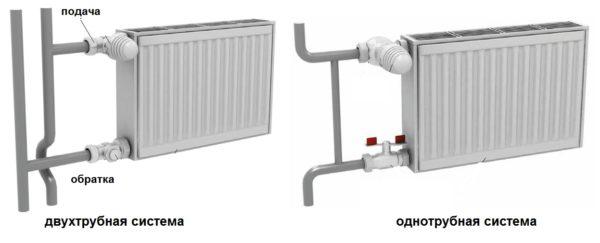
Με αυτή τη σύνδεση των θερμαντικών σωμάτων, η απόδοση θέρμανσης είναι μόνο ελαφρώς χαμηλότερη - κατά 2%. Αλλά αυτό ισχύει μόνο εάν υπάρχουν μόνο λίγα τμήματα στα θερμαντικά σώματα - όχι περισσότερα από 10. Εάν το θερμαντικό σώμα είναι μεγαλύτερο, το μακριά από την άκρη του θα θερμαίνεται ανεπαρκώς ή θα παραμένει καθόλου κρύο. Στα ψυγεία πάνελ για να λύσετε το πρόβλημα βάλτε επεκτάσεις ροής - σωλήνες που φέρνουν το ψυκτικό υγρό ακριβώς πέρα από τη μέση. Οι ίδιες συσκευές μπορούν να τοποθετηθούν σε αλουμινένια ή διμεταλλικά ψυγεία, βελτιώνοντας την απόδοση θερμότητας.
Επιλογή αριθ. 3: Σύνδεση στο κάτω μέρος ή στη σέλα
Από όλες τις επιλογές, η τμηματική σύνδεση των θερμαντικών σωμάτων είναι η λιγότερο αποδοτική. Οι απώλειες είναι περίπου 12-14%. Αλλά αυτή η επιλογή είναι η πιο δυσδιάκριτη - οι σωλήνες τοποθετούνται συνήθως στο δάπεδο ή κάτω από αυτό και αυτή η μέθοδος είναι η καλύτερη από άποψη αισθητικής. Και για να μην επηρεάζουν οι απώλειες τη θερμοκρασία στο δωμάτιο, μπορείτε να πάρετε ένα καλοριφέρ λίγο πιο ισχυρό από ό, τι απαιτείται.
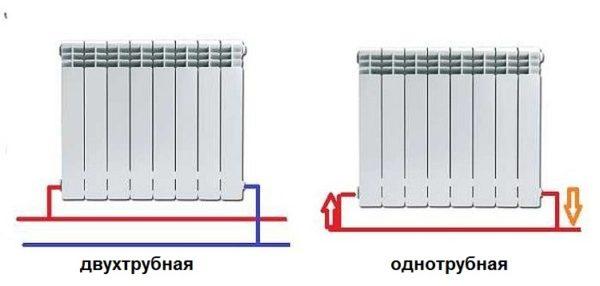
Σε συστήματα με φυσική κυκλοφορία, αυτός ο τύπος σύνδεσης δεν πρέπει να γίνεται, αλλά με την παρουσία αντλίας, λειτουργεί αρκετά καλά. Σε ορισμένες περιπτώσεις, δεν είναι χειρότερη από την πλευρική. Απλώς σε κάποια ταχύτητα κίνησης του ψυκτικού υγρού υπάρχουν ροές στροβίλου, ολόκληρη η επιφάνεια θερμαίνεται, η μεταφορά θερμότητας αυξάνεται. Αυτά τα φαινόμενα δεν έχουν ακόμη κατανοηθεί πλήρως, οπότε είναι αδύνατο να προβλεφθεί η συμπεριφορά του ψυκτικού υγρού.


